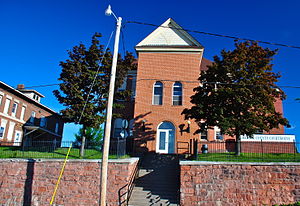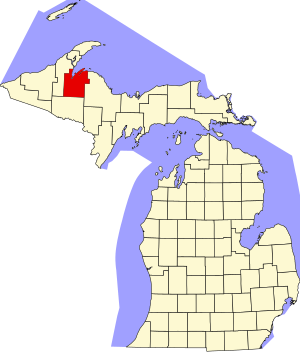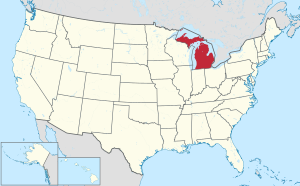|
Baraga County, Michigan
Baraga County (/ˈbɛərəɡə/ BAIR-ə-gə) is a county in the Upper Peninsula in the U.S. state of Michigan. As of the 2020 census, the population was 8,158, making it Michigan's fifth-least populous county.[3] The county seat is L'Anse.[4] The county is named after Bishop Frederic Baraga, a Catholic missionary who ministered to the Ojibwa Indians in the Michigan Territory.[1] The L'Anse Indian Reservation of the Ojibwa is within Baraga County. Geography According to the U.S. Census Bureau, the county has a total area of 1,069 square miles (2,770 km2), of which 898 square miles (2,330 km2) is land and 171 square miles (440 km2) (16%) is water.[5] The county is located in the state's Upper Peninsula on the shore of Lake Superior, at the southeast base of the Keweenaw Peninsula. The villages of Baraga and L'Anse are located at the base of Lake Superior's Keweenaw Bay. Point Abbaye projects north into the lake, enclosing Huron Bay. The eastern two-thirds of the county includes much of the Huron Mountains, including Mount Arvon—the highest natural point in Michigan at 1,979 feet (603 m). Major highways
Adjacent counties
National protected areas
Communities VillagesCivil townshipsCensus-designated placesOther unincorporated communitiesIndian reservations
Demographics
The 2010 United States census indicated Baraga County had a population of 8,860.[11] This was an increase of 114 people from 2000. In 2010 there were 3,444 households and 2,209 families in the county. The population density was 10 people per square mile (3.9 people/km2). There were 5,270 housing units at an average density of 6 per square mile (2.3/km2). Among the county, 75.0% of the population was White, 13.1% Native American, 7.2% Black or African American, 0.1% Asian, 0.2% of some other race and 4.4% of two or more races; 1.0% were Hispanic or Latino (of any race). Additionally, 22.5% were of Finnish, 9.1% German, 8.8% French, French Canadian or Cajun, 5.6% English and 5.5% Irish ancestry.[12] By the 2020 census, its population was 8,158.[3] In 2010, there were 3,444 households, out of which 25.2% had children under the age of 18 living with them, 47.4% were married couples living together, 10.9% had a female householder with no husband present, and 35.9% were non-families. Of all households, 31.6% were made up of individuals, and 13% had someone living alone who was 65 years of age or older. The average household size was 2.28 and the average family size was 2.82. The age distribution of the county population was the following: 20.2% were under the age of 18, 7% from 18 to 24, 25.7% from 25 to 44, 29.7% from 45 to 64, and 17.2% who were 65 years of age or older. The median age was 42.9 years; 54.9% of the population was male, 45.1% was female. As of 2010, the median income for a household in the county was $40,115, and the median income for a family was $50,996. The per capita income for the county was $19,076. About 9.5% of families and 13% of the population were below the poverty line, including 19.2% of those under age 18 and 6.7% of those age 65 or over. By the 2021 census estimates, its median household income was $45,792.[3] GovernmentBaraga County has tended to support Republican candidates. Since 1884 its voters have selected the Republican Party nominee in 67% (24 of 36) of the national elections through 2024, and in all presidential elections since 2000.
Baraga County operates the county jail, maintains rural roads, operates the major local courts, records deeds, mortgages, and vital records, administers public health regulations, and participates with the state in the provision of social services. The county board of commissioners controls the budget and has limited authority to make laws or ordinances. In Michigan, most local government functions – police and fire, building and zoning, tax assessment, street maintenance etc. – are the responsibility of individual cities and townships. See also
References
External links |
|||||||||||||||||||||||||||||||||||||||||||||||||||||||||||||||||||||||||||||||||||||||||||||||||||||||||||||||||||||||||||||||||||||||||||||||||||||||||||||||||||||||||||||||||||||||||||||||||||||||||||||||||||||||||||||||||||||||||||||||||||||||||||||||||||||||||||||||||||||||||||||||||||||||||||||||||||||||||||||||||||||||||||||||||||||||||||||||||||||||||||||||||||||||||||||||||





